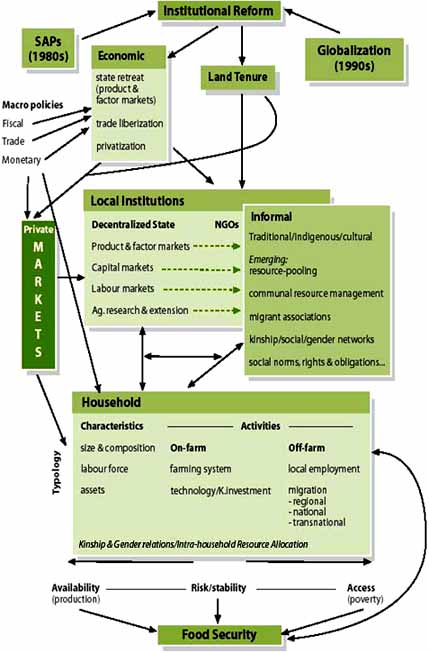The SDAR/FAO research programme was undertaken to gain greater understanding of the linkages between household livelihood strategies and the local institutional environment, and how these linkages may change over time. The research focused on economic institutions associated with household access to land, labour, markets and capital, as well as those providing a social safety net.
In this paper, and in the SDAR/FAO research programme, local institutions are defined broadly to comprehend the many types of extra-household arrangements that individuals or households engage in to further their mutual goals. Institutions are often referred to as "rules of the game" (North 1995), meaning the social norms and traditions that establish what types of behaviour are "normal" in society. This coincides with the definition proposed by Norman Uphoff in which institutions are "complexes of norms and behaviours that persist over time by serving some collectively valued purpose" (Uphoff 1997:6). Institutions may be formal or informal: where formal institutions stipulate rules such as constitutions, laws and property rights, while informal institutions are generally agreed upon arrangements or rules of behaviour such as sanctions, taboos, customs, traditions, and codes of conduct (North 1991). Local organizations4 and associations or groups, such as women's groups, farmer associations, and savings and credit arrangements are at different stages of "institutionalization". The SDAR/FAO publication: Guidelines for Understanding Linkages between Household Livelihood Strategies and Local Institutions (forthcoming 2002) will provide a useful framework for categorizing local institutions and organizations by placing them on three continuums: (in) visibility, (ex) inclusivity and purpose (normative vs. practical).
The concept of "social capital" is closely related to local institutions and collective action. The World Bank Social Capital Initiative, drawing on the work of Robert Putnam, James Coleman, and David North, defines social capital as: "the norms [reciprocity, trust], networks and social relations embedded in social structures [local institutions] of society that enable people to coordinate action and achieve desired goals".5 These social relations determine attitudes of sympathy (or antipathy) and obligations, and go far to explain peoples' relative willingness to collaborate in collective action. Local institutions, therefore, reflect some of the "stock" and quality of social capital in a particular context.
Figure 1: Sustainable Livelihoods Analytical Framework

Source DFID
Institutions are of concern because of their linkages to household livelihood strategies and outcomes, for instance, in providing access to assets, sources of income, reducing vulnerability, and mitigating adverse consequences of economic policies, civil strife and other external shocks. There is, therefore, a clear connection between this research and the Sustainable Livelihoods Approach developed by UNDP, DFID and others, that has recently gained great recognition and enthusiasm.6 More specifically, we address the part of the Sustainable Livelihoods Framework (Figure 1) that links livelihood assets with policies, institutions, and processes - PIP. The connection can be seen again by comparing Figure 1 with the original SDAR/FAO research design (Figure 2).
Figure 2

The main contribution of this research, therefore, is to further understanding of the attributes of local institutions and linkages of these institutions with the livelihoods of the rural poor. From a policy point of view, this enhanced understanding can lead to a more constructive or enabling policy environment for effective collaboration with local institutions in designing and implementing local development initiatives. Special attention is paid to issues of local legitimacy and democratic representation or inclusion, attributes which cannot be taken for granted when working with local institutions.